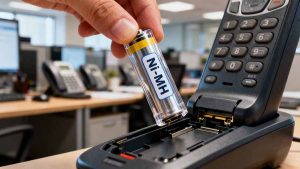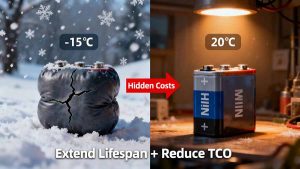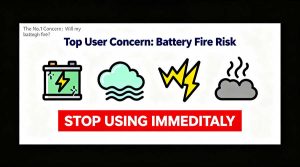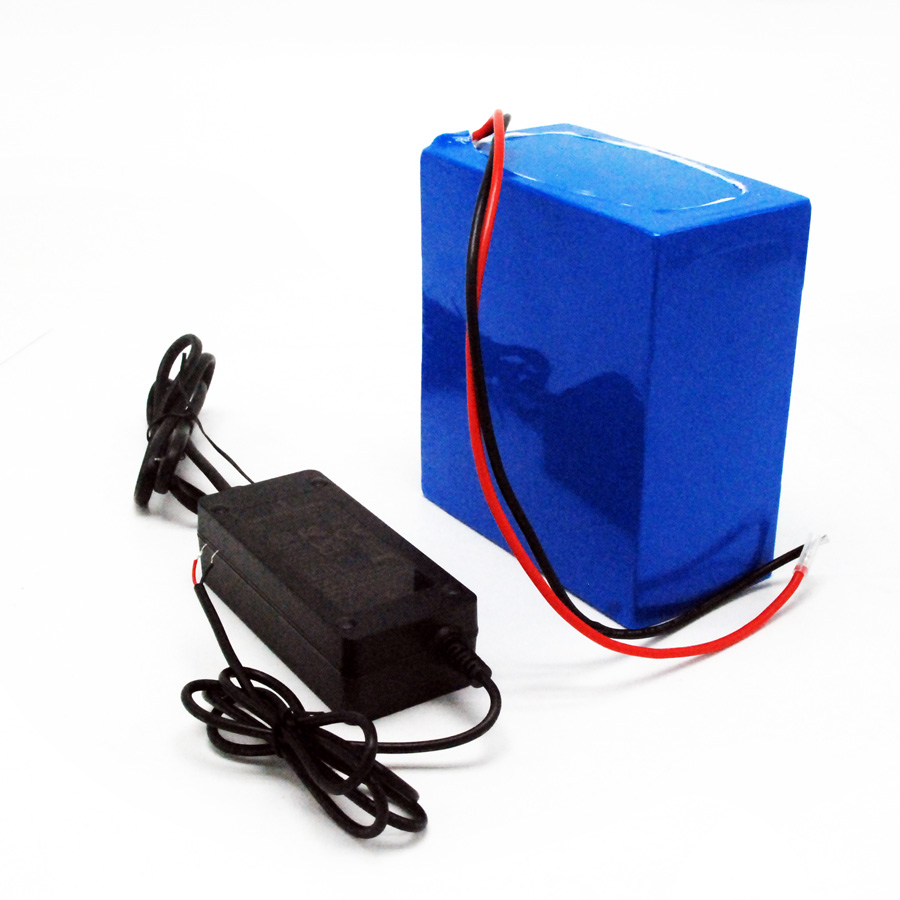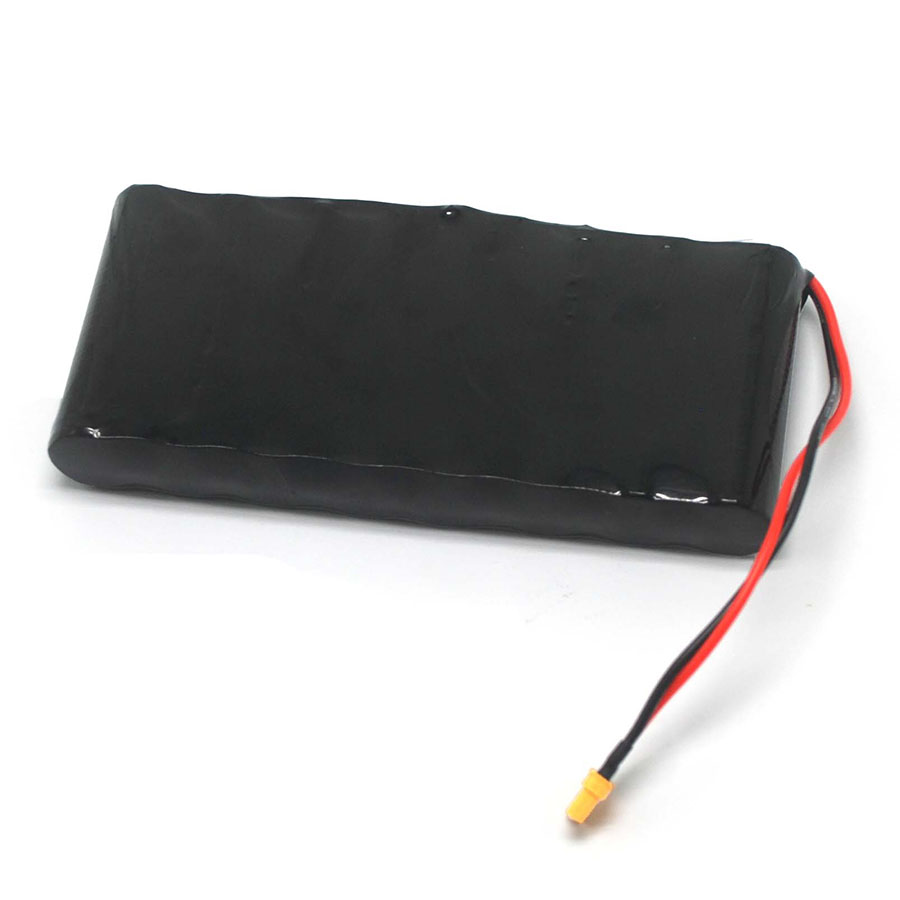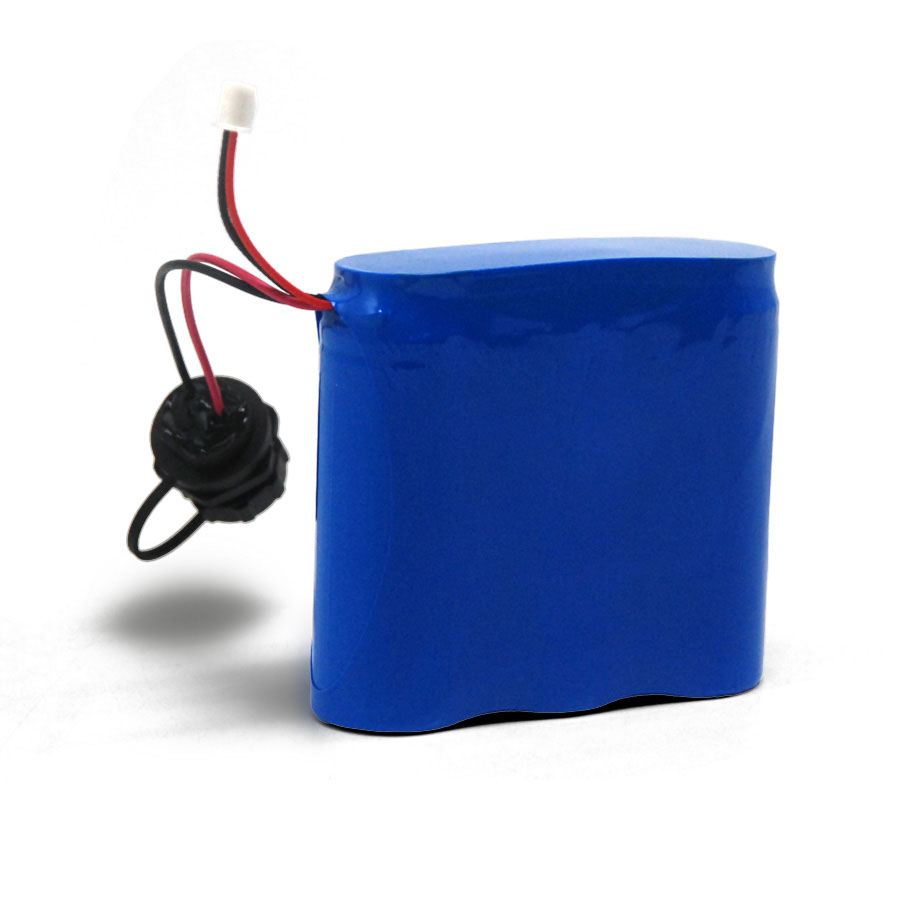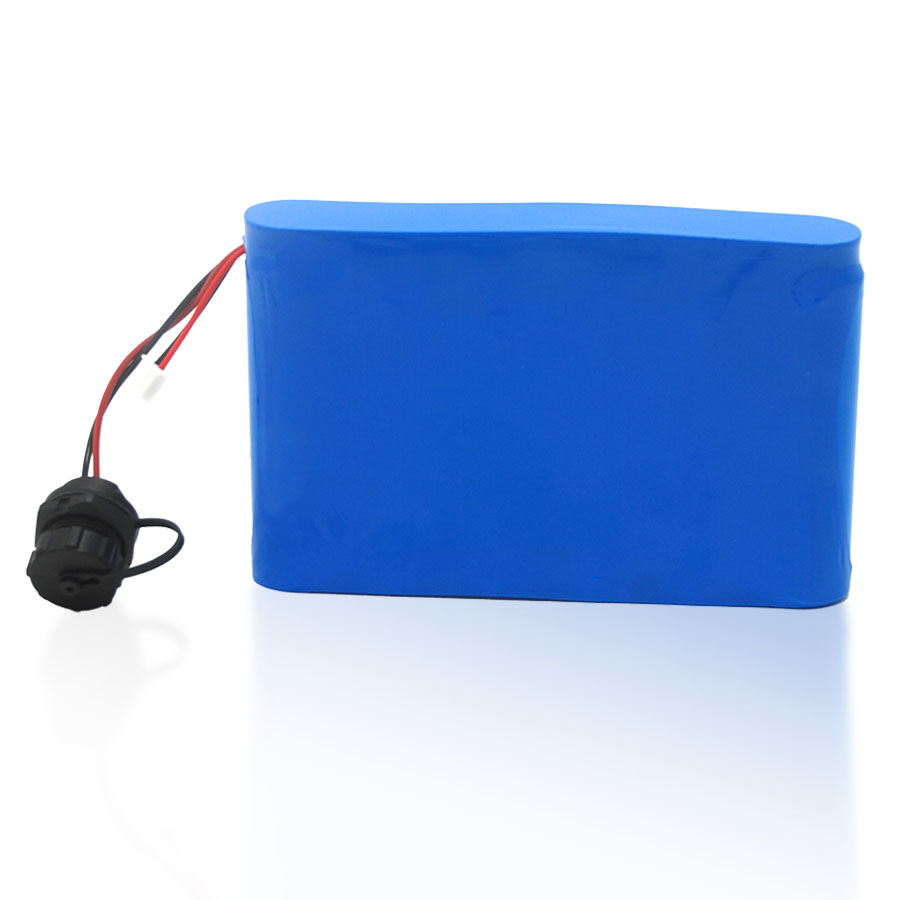Selecting the right 48 V golf cart battery has never been more critical. Whether you’re running a private golf course, managing a fleet of rental carts, or simply seeking better performance and reliability, choosing the ideal battery pack can transform your operation. In 2025, LiFePO₄ (Lithium Iron Phosphate) technology leads the market thanks to superior safety, long cycle life, and consistent performance under load. In this comprehensive guide—tailored for readers of HimaxBattery.com—we’ll explore the fundamentals of 48 V battery types, compare key specifications, and spotlight the all-new Himassi 48 V 100 Ah LiFePO₄ Battery (with Bluetooth, intelligent display, and an optimized charger). By the end, you’ll understand exactly what to look for and why upgrading to a LiFePO₄ golf cart battery makes sense for your budget and performance needs.
Contents
1. Part 1. Understanding 48 V Golf Cart Battery Types
2. Part 2. Is a 48 V Lithium Golf Cart Battery the Best?
3. Part 3. Why Is a 48 V Golf Cart Battery Different?
4. Part 4. What Voltage Battery Do I Need?
5. Part 5. Best 48 V Golf Cart Battery Specifications
5.1. Capacity (Ah)
5.2. Charging Time
5.3. Discharge Rate
5.5. Featured Spotlight: Himassi 48 V 100 Ah LiFePO₄ Battery
6. Part 6. Why Should You Care About Golf Cart Battery Capacity?
7. Part 7. How Much Do 48 V Golf Cart Batteries Cost?
8. Part 8. Choose the Right Charger
9. Part 9. Maintenance and Charging
10. Part 10. Should You Upgrade to a 48 V Lithium Battery?
11. Part 11. When Should You Replace Your Battery?
12. Part 12. FAQs
12.1. Are lithium-ion batteries safer than lead-acid for golf carts?
12.2. Can I mix different types of batteries in my golf cart?
12.3. Can I use a 12 V charger on a 48 V golf cart battery?
12.4. What is the capacity of a typical 48 V golf cart battery?
12.5. How do I safely dispose of old 48 V golf cart batteries?
12.6. What makes the Himassi 48 V 100 Ah LiFePO₄ Battery stand out?
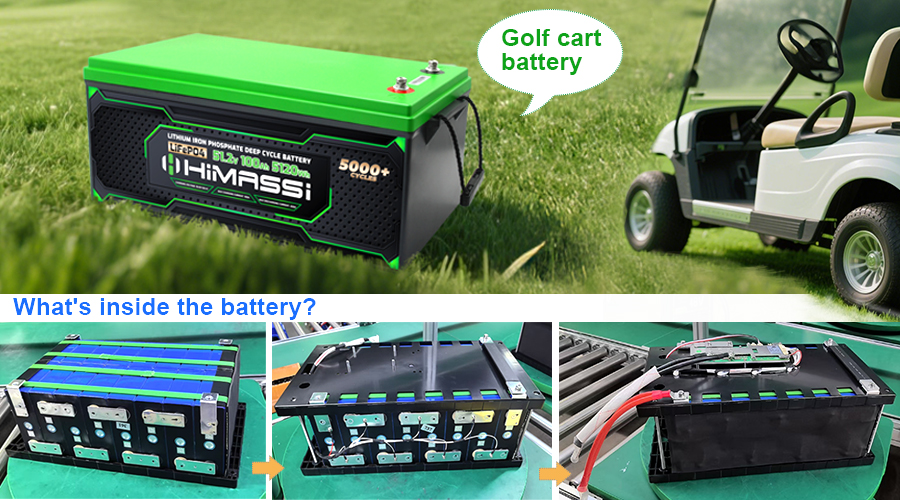
Part 1. Understanding 48 V Golf Cart Battery Types
Golf cart batteries historically fell into two main categories:
1.Lead-Acid Batteries
· Pros: Low upfront cost, widespread availability, proven track record.
· Cons: Heavy (often > 300 lb for a full 48 V bank), frequent watering and equalization required, cycle life limited to 400–800 cycles, and sulfation risk if discharged too deeply. Because lead-acid cells discharge voltage quickly under load, carts can lose speed toward the end of a round.
2.Lithium-Ion Batteries (LiFePO₄)
· Pros: Up to 80 % lighter than lead-acid, 3,000–6,000+ cycles at 80 % DoD, fast charging, minimal maintenance, built-in Battery Management Systems (BMS) for safety, and consistent voltage under heavy load. LiFePO₄ chemistry is thermally stable and highly resistant to thermal runaway.
· Cons: Higher initial investment. However, total cost of ownership often pays off within 2–4 years for frequent-use fleets, thanks to reduced maintenance and longer useful lifespan.
As of 2025, LiFePO₄ technology dominates new golf cart battery installations, and most leading manufacturers focus on 48 V LiFePO₄ packs. The remainder of this guide will treat LiFePO₄ as the preferred option for any serious operator.
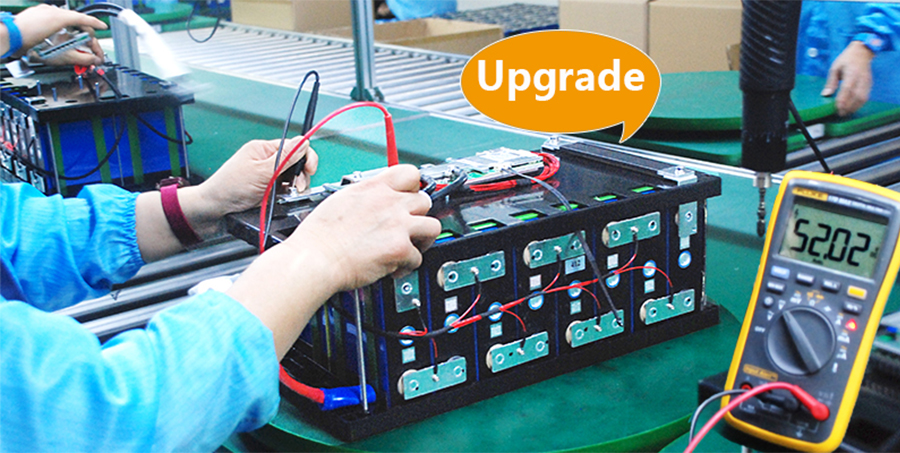
Part 2. Is a 48 V Lithium Golf Cart Battery the Best?
Key Advantages of 48 V LiFePO₄ over Lead-Acid:
· Longevity: A well-engineered 48 V LiFePO₄ pack can easily exceed 3,000 charge/discharge cycles. In contrast, lead-acid rarely makes it beyond 800 cycles before capacity falls below 60 %.
· Weight Savings: A LiFePO₄ 48 V 100 Ah pack typically weighs ~120 lb (≈ 54 kg), whereas an equivalent lead-acid bank (six 8 V 200 Ah golf cart batteries) exceeds 300 lb (≈ 136 kg). Reduced weight translates directly into better acceleration, longer hill-climbing capability, and less stress on suspension and brakes.
· Maintenance: LiFePO₄ requires no watering, periodic equalization, or acid-level checks. The integrated BMS handles cell balancing, over-charge/discharge protection, and temperature monitoring.
· Performance Consistency: LiFePO₄ maintains a flat discharge curve (45 V–50 V under load), meaning power does not taper off rapidly as the battery drains—unlike lead-acid, which drops voltage significantly under load, especially at partial charge.
· Faster Charging: Many LiFePO₄ packs can recharge from 20 % to 90 % in 2–4 hours, whereas lead-acid often takes 6–8 hours for a full charge. This allows for midday charging or quick top-ups between rounds.
· Environmental & Safety: LiFePO₄ chemistry contains no heavy metals like lead and avoids acid spills. Its thermal stability makes it far less prone to fire, even under abuse.
Potential Drawbacks to Consider:
· Upfront Cost: LiFePO₄ pack prices typically range $2,000–$3,500 for a 48 V 100 Ah battery (depending on brand and features). Lead-acid can be $600–$1,200 for an equivalent bank.
· BMS Complexity: If the pack’s BMS is poorly configured or undersized, it may cut off prematurely or fail to balance properly. Always choose a reputable brand with a proven BMS.
· Charger Compatibility: LiFePO₄ cells require a charger with a higher cut-off voltage (around 58.4 V for a 48 V pack) and a BULK-ABSORB-FLOAT profile optimized for LiFePO₄ chemistry. Using a generic lead-acid charger can damage the pack over time.
Overall, if you use your golf cart multiple times per week—or manage a small fleet—the long-term benefits of LiFePO₄ generally outweigh the initial premium. In particular, the new Himassi 48 V 100 Ah LiFePO₄ Battery (featured below) represents one of the most cost-effective, feature-rich options available in 2025.
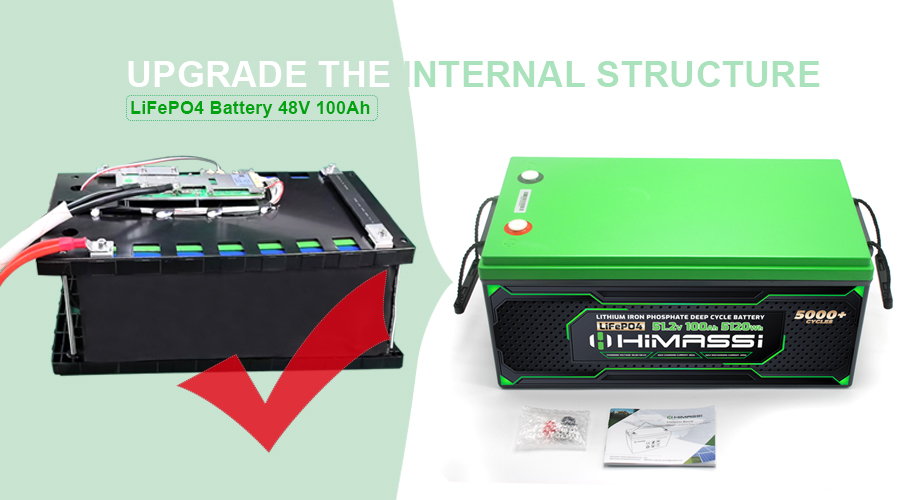
Part 3. Why Is a 48 V Golf Cart Battery Different?
Many operators wonder: “Why not stick with a 36 V system or even a 48 V lead-acid pack?” In short, 48 V LiFePO₄ offers distinct advantages:
· Higher Power Capacity: A 48 V battery delivers 33 % more voltage than a 36 V pack, translating into improved torque, faster acceleration, and higher top speed—especially noticeable on inclines.
· Greater Energy Efficiency: Modern golf cart motors and controllers optimize for 48 V. Running at a higher voltage means lower current for equivalent power, reducing resistive losses in cabling and improving overall system efficiency.
· Compatibility with Accessories: Many GPS systems, LED lighting kits, and high-powered audio systems in 2025 are designed to run off 48 V DC, making integration seamless.
· Future Proofing: As courses and fleets upgrade chargers, solar-powered charging stations, and telematics, 48 V LiFePO₄ is the most common standard. Swapping to a 36 V system today might limit your ability to add these features later.
Because 48 V LiFePO₄ has become the de facto standard for new high-performance golf carts, it’s the logical choice for any installation where longevity, efficiency, and reliability matter.
Part 4. What Voltage Battery Do I Need?
36 V Systems
· Use-Case: Smaller or entry-level carts, par-3 courses, limited-range applications (e.g., rental carts that only go short distances).
· Pros: Lower initial cost, lighter cabling.
· Cons: Reduced torque, lower top speed, less efficient—particularly under load or on hilly terrain.
48 V Systems
· Use-Case: Most modern golf courses, rental fleets, private clubs, industrial campuses—especially where carts run > 40 mi per day or encounter varied terrain.
· Pros: Improved acceleration, higher top speed, better climbing capability, more efficient power usage, compatibility with standard LiFePO₄ packs.
· Cons: Slightly higher upfront wiring costs (bigger gauge cables).
For any serious operator—daily-use fleet or performance-driven private cart—48 V LiFePO₄ is the clear winner. Aside from power benefits, the global availability of high-quality 48 V LiFePO₄ packs like Himassi (100 Ah, 150 Ah, 200 Ah, and beyond) ensures long-term support and parts availability.
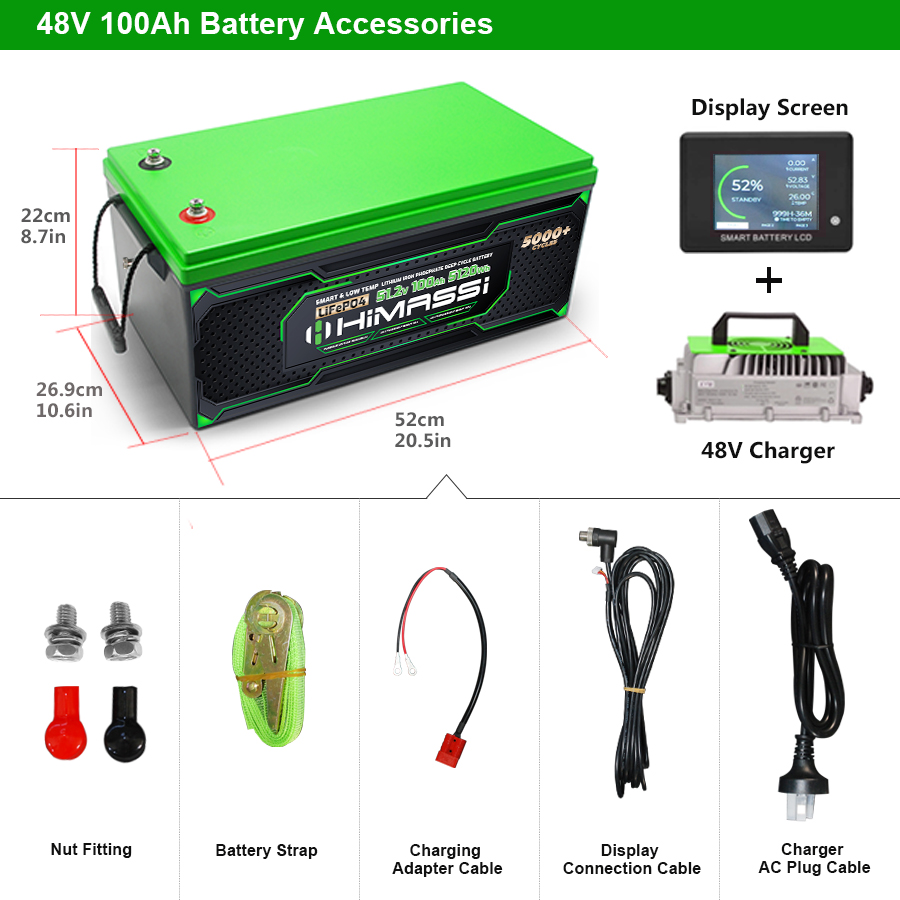
Part 5. Best 48 V Golf Cart Battery Specifications
When comparing 48 V LiFePO₄ battery packs, focus on these core specifications:
5.1 Capacity (Ah)
· Definition: Ampere-hours (Ah) measure how much charge a battery can store. Multiply Ah × 48 V to get total energy in watt-hours (Wh). For example, a 48 V 100 Ah pack equals 4,800 Wh (4.8 kWh) of energy.
· Practical Impact:
O A 48 V 100 Ah pack typically delivers 80 Ah usable (assuming 80 % Depth of Discharge).
O A 48 V 200 Ah pack delivers ~160 Ah usable, doubling runtime.
O Higher Ah means longer runtime per charge (e.g., a 100 Ah pack might cover 36 holes for a single rider, whereas a 200 Ah pack can run multiple rounds or multiple riders back-to-back without recharging).
5.2 Charging Time
· Importance: Faster charge means less downtime between rounds or shifts.
· Typical Values:
O Many 48 V LiFePO₄ packs (100 Ah) accept 25 A–50 A charge currents, allowing 80 % recharge in roughly 2–4 hours.
O Chargers with multiple stages (bulk, absorb, float) and temperature compensation optimize battery life while minimizing charge time.
O Using a compatible LiFePO₄-specific charger (e.g., a 48 V 30 A charger for a 100 Ah pack) is essential; standard lead-acid chargers often undercharge or overcharge, shortening pack lifespan.
5.3 Discharge Rate
· Definition: Maximum continuous and peak current a battery can safely supply without triggering BMS cut-off or overheating.
· Why It Matters:
O Peak discharge capacity affects hill-climbing power and ability to carry heavier loads (e.g., multiple passengers, cargo).
O A pack rated for 100 A continuous discharge can support most golf cart demands; higher-performance carts may require 150 A–200 A peak output.
O Look for C-rating (e.g., 1 C for 100 Ah pack equals 100 A continuous) and peak discharge specs.
5.4 Temperature Tolerance
· Definition: The operating temperature range over which a battery can charge or discharge safely.
· Considerations:
O LiFePO₄ chemistry is inherently more stable than other lithium types, performing well from –10 °C to 55 °C.
O Many high-end packs include low-temperature cutoff (< 0 °C) to prevent charging when cells could be damaged, as well as built-in heaters or BMS-controlled warming.
O If your golf course experiences sub-freezing winters, choose a pack with low-temp protection and optional heating elements.
5.5 Featured Spotlight: Himassi 48V 100Ah LiFePO₄ Battery
Himassi—a premium sub-brand from Himax Battery—unveiled its upgraded 48 V 100 Ah LiFePO₄ Battery in Q1 2025. Designed specifically for golf cart, RV, and small-EV applications, Himassi elevates the standard LiFePO₄ pack with advanced features and factory-direct pricing. Here’s why this battery stands out:
1.Upgraded Chemistry & Cycle Life
O Utilizes high-quality 32700 LiFePO₄ cells rated at 6,000 mAh each (4,000–6,000 cycles at 80 % DoD).
O Expected to retain > 80 % capacity after 4,500 cycles in typical golf-cart duty cycles—an industry-leading benchmark.
2.Built-In Bluetooth Connectivity
O Integrated Bluetooth module streams real-time data (State of Charge, voltage per cell, temperature, cumulative Amp-hours) directly to the Himassi smartphone app (iOS/Android).
O Push notifications for low SOC, high temperature, or anomalous cell voltage ensure proactive maintenance—no more surprise cut-outs on the course.
3.Intelligent LCD Display
O Front-panel LCD shows instant readouts of pack voltage (to 0.01 V), current (±0.1 A), individual cell min/max voltages, and pack temperature.
O User-selectable display modes: Standard (total SOC and runtime estimate) or Advanced (per-cell voltages and historical cycle count).
O Backlit screen automatically dims in low-light conditions, ensuring legibility during dusk rounds.
4.Included Dedicated 48 V LiFePO₄ Charger
O Himassi’s 48 V 30 A smart charger is tuned to the pack’s chemistry, delivering a three-stage charge profile (Bulk → Absorb → Float).
O Charge time from 10 % to 90 % typically takes 2.5 hours; a full 0 %→100 % cycle completes in ~4 hours.
O Over-temperature and over-voltage protections built into charger, preventing excessive stress on pack cells.
5. Form Factor & Mounting Options
O Dimensions: 520 × 280 × 220 mm (20.5 × 11 × 8.7 in) with reinforced aluminum enclosure, weather-resistant IP65 rating.
O Weight: 54 kg (119 lb), roughly 60 % lighter than a comparable lead-acid bank.
O Compatible with standard golf cart battery trays (drop-in fit for most Club Car, EZ-GO, Yamaha) and rack-mount kits for enclosed-cab carts.
O Cable harness with M6 threaded studs and color-coded connectors for straightforward installation.
6.Warranty & After-Sales Support
O Covered by a 5-year full warranty (prorated after year 3), guaranteeing ≥ 80 % capacity retention at 2,500 cycles.
O Himassi’s dedicated customer service hotline (24 × 7) and local authorized service centers in North America and Europe.
O Replacement modules (single cell blocks) available for field-serviceable repairs, minimizing downtime.
Because Himassi assembles these packs in their state-of-the-art factory in Shenzhen (with ISO-9001 QC) and delivers direct to global distributors, bulk pricing drops below $600 per kWh for orders of 10+ units. For golf course operators, that translates into a 48 V 100 Ah pack MSRP of $2,800 (with charger included), compared to $3,200–$3,500 for competing premium brands—while still providing superior cycle life, monitoring, and local support.
Part 6. Why Should You Care About Golf Cart Battery Capacity?
Golf cart battery capacity—measured in Ah—directly affects:
· Runtime per Charge: A higher Ah rating means longer playtime. For example, a typical golfer expending ~10 Ah per 18 holes:
O A 48 V 100 Ah pack yields roughly 8–9 rounds before hitting 20 % SOC if you cycle once per round.
O A 48 V 200 Ah pack could support 16–18 rounds under the same conditions or accommodate multiple riders per cart.
· Weight & Balance: Larger capacity often means more cells or larger cell formats. Himassi’s 100 Ah pack uses 32700 cells to maximize energy density, balancing capacity and weight.
· Total Cost of Ownership: More capacity on a single pack reduces the need for frequent recharging or multiple batteries. Even though a 48 V 200 Ah pack costs more upfront, the cost per usable Wh often drops.
· Fleet Scheduling: Fleet operators can schedule fewer charging sessions per day if each cart can last multiple rounds on a single charge, reducing downtime and charger congestion.
· Especially for courses experiencing high foot traffic or rentals, investing in a pack with sufficient capacity ensures smooth operations and happier golfers. Himassi offers 48 V 150 Ah and 200 Ah variants built on the same platform, ideal for large fleets or courses in hilly regions where energy consumption per hole increases.
Part 7. How Much Do 48 V Golf Cart Batteries Cost?
When budgeting for a 48 V golf cart battery, consider both upfront cost and long-term value.
1.Lead-Acid 48 V Bank
O Typical cost for six 8 V 210 Ah flooded lead-acid batteries: $600–$1,200 (depending on brand and warranty).
O Replacement every 3–4 years for fleets, plus regular watering, equalization, and maintenance costs (~$150–$200 /yr in service labor per cart).
2.Entry-Level 48 V LiFePO₄ (Generic Brands)
O Basic 48 V 100 Ah LiFePO₄ packs (no Bluetooth, no display, simple BMS) run $2,000–$2,400.
On Most include an off-the-shelf 48 V 25 A charger (sold separately for $300–$500).
O Cycle life around 3,000 cycles at 80 % DoD.
3.Premium 48 V LiFePO₄ (Battle Tested Brands)
O Packs from established RV or marine vendors (Battle Born, Victron, Trojan) cost $3,200–$3,500 for a 48 V 100 Ah module.
O Bundled charger often optional or costs an extra $400–$600.
O Cycle life 4,000–5,000 cycles; robust BMS with CANBus/RS485.
4.Himassi 48 V 100 Ah LiFePO₄ Battery with Charger
O MSRP $2,800 (includes dedicated 48 V 30 A LiFePO₄ charger).
O Bulk orders (10+ units) reduce unit cost to $2,600.
O Cycle life 4,500+ cycles at 80 % DoD; full-feature BMS with Bluetooth and LCD display.
O Local after-sales support and field-serviceable modules reduce downtime costs.
5.48 V 200 Ah LiFePO₄ Options
O Generic 48 V 200 Ah LiFePO₄: $4,200–$4,600 (charger sold separately).
O Himassi 48 V 200 Ah: $4,200 with bundled 48 V 60 A charger (3–4 hour recharge). Bulk pricing can drive it as low as $3,800 per unit.
Total Cost of Ownership (TCO) Comparison (5 Year Horizon, Fleet of 10 Carts)
| Item | Lead-Acid (10 x 48 V 210 Ah) | Generic LiFePO₄ (10 x 48 V 100 Ah) | Premium LiFePO₄ (10 x 48 V 100 Ah) | Himassi LiFePO₄ (10 x 48 V 100 Ah) |
| Upfront Battery Cost | $8,000 | $24,000 | $33,000 | $26,000 |
| Chargers (25 A x 10) | $0 (usually included with carts) | $3,000 | $4,000 | Included |
| Maintenance & Service (5 yrs) | $15,000 | $1,000 | $500 | $500 |
| Replacement (Year 3 Lead-Acid) | $8,000 | N/A | N/A | N/A |
| Total 5-Year TCO | $31,000 | $28,000 | $37,500 | $27,000 |
· Insight: Even though lead-acid has the lowest initial cost, maintenance and mid-life replacement drive its 5-year TCO up to $31 k.
· Generic LiFePO₄ cuts maintenance dramatically but still has higher TCO due to separate charger purchases.
· Premium LiFePO₄ from top RV/marine brands yields highest 5-year TCO, mainly because of higher unit price.
· Himassi LiFePO₄ delivers the lowest 5-year TCO ($27 k) thanks to integrated charging solution, fewer replacements, and low maintenance.
Clearly, investing in a quality LiFePO₄ pack like Himassi pays off quickly when you factor in maintenance, downtime, and replacement cycles. For fleet operators, the “buy once, buy right” philosophy leads to lower overall costs and smoother operations.
Part 8. Choose the Right Charger
A proper charger is critical to maximize LiFePO₄ battery lifespan and performance. When selecting a charger, consider these factors:
1.Chemistry Compatibility
O LiFePO₄ vs. Lead-Acid Profiles: LiFePO₄ charging requires a higher cutoff voltage—typically 58.4 V (3.65 V per cell in a 16-cell 48 V configuration). Lead-acid chargers top out at ~56 V, which undercharges LiFePO₄ packs and leads to sulfate buildup (on early LiFePO₄ conversion attempts).
O Temperature Compensation: Charging at low temperatures (< 0 °C) can damage LiFePO₄ cells. A LiFePO₄-specific charger incorporates a temperature sensor and will either reduce current or postpone bulk charging until the pack is above a safe threshold.
2.Charging Current (Amp Rating)
O Ideal C-Rate: LiFePO₄ cells accept up to 0.5 C (e.g., 50 A for a 100 Ah pack) safely. However, charging at 0.3 C (30 A) strikes a balance between speed and longevity. Himassi’s 48 V 30 A charger charges a 100 Ah pack from 10 % to 90 % in ~2.5 hours without excessive cell heating.
O Adjustable Output: Chargers that allow dial-in of charge current (e.g., 10 A–60 A) help tailor to different pack sizes. If you have a 48 V 200 Ah pack, you could use the same charger at 60 A to recharge in ~3 hours.
3. Safety & Protection Features
O Over-Temperature Cutoff: Charger shuts down if internal or battery temperature exceeds safe limits.
O Open-Circuit Detection: Prevents high-voltage arcing if battery is disconnected.
O Reverse Polarity Protection: Avoids damage if cables are accidentally reversed.
O Auto-Resume/Float Mode: Maintains a small float charge (≥ 3.4 V per cell) to counter self-discharge without overcharging.
4. Form Factor & Installation
O Wall-Mount vs. Floor-Mount: For a fleet shop, a floor-mount charger with integrated wheels may be more practical. For individual carts, a lightweight wall-mount model (e.g., Himassi’s 48 V 30 A charger) conserves floor space.
O Connector Type: Look for chargers with large M6/M8 ring terminals (≥ 8 AWG cables) or Anderson plug options for quick connect/disconnect.
Since Himassi’s 48 V 100 Ah pack includes a matched 30 A LiFePO₄ charger, you bypass the guesswork. The charger’s firmware automatically maximizes charge speed while preserving cycle life—no additional investment required beyond plugging in the cable.
Part 9. Maintenance and Charging
Proper maintenance and charging habits extend battery lifespan, especially for LiFePO₄ packs. Follow these best practices:
1.Avoid Deep Discharge
O LiFePO₄ Optimal DoD: Stay above 20 % State of Charge. The Himassi BMS issues smartphone alerts when SOC dips below 25 %, ensuring you return to the clubhouse before hitting 20 %.
O Carts with Integrated Telemetry: If your cart’s controller supports CANBus, you can monitor pack voltage in real time. Otherwise, rely on the Himassi Bluetooth app to gauge SOC and schedule timely recharges.
2.Regular Charging Cadence
O Post-Round Charging: Recharge within 2 hours of returning to avoid prolonged idling at low SOC, which can stress LiFePO₄ cells.
O Trickle/Float Charging: Once the pack reaches 100 %, switch off or set charger to float mode. LiFePO₄ has near-zero self-discharge, so continuous float isn’t necessary—occasional top-up once per week is sufficient.
3. Temperature & Weather Considerations
O Cold Weather: LiFePO₄ cells should not be charged below 0 °C. Himassi’s charger prevents bulk charging until pack temperature rises to at least 5 °C. If carts sit outdoors in winter, bring them into a heated garage to charge.
O Hot Weather: Operating above 45 °C repeatedly may accelerate cell degradation. Park carts in shaded or air-conditioned areas when not in use. The Himassi pack monitors internal temperature and will automatically throttle discharge if cells exceed 55 °C.
4.Cleaning and Inspection
O Terminals & Connectors: Check for corrosion or loose connections every month. Tighten M6 studs to the manufacturer-specified torque (≈ 6 N·m) and apply a thin layer of dielectric grease to prevent moisture ingress.
O Enclosure Exterior: Wipe dust or dirt from vents to ensure proper heat dissipation. Himassi’s IP65-rated cabinet resists water and dust, but accumulated debris can obstruct airflow.
O BMS Logs: Review cycle count and voltage logs via the Himassi app every quarter. If you notice any cell consistently outside ± 10 mV of pack average, schedule a field-service inspection.
By following these straightforward steps, you ensure your 48 V LiFePO₄ battery delivers peak performance year after year.
Part 10. Should You Upgrade to a 48 V Lithium Battery?
Performance Gains
· Weight Reduction:
O Upgrading from six 8 V lead-acid blocks (≈ 300 lb) to a single Himassi 48 V 100 Ah LiFePO₄ pack (≈ 119 lb) results in a 60 % weight saving. This improves handling, braking, and slope performance.
· Consistent Voltage Under Load:
O LiFePO₄ maintains a nearly flat voltage curve (50 V → 48 V → 46 V) until near depletion. Lead-acid drops more steeply (48 V → 42 V → 36 V), causing “sluggish” throttle response late in rounds.
· Faster Recharge:
O A typical golf course may schedule six 20 A chargers. Even if all carts return simultaneously at 5 pm, the Himassi pack can recharge to 80 % by 8 pm, ready for a twilight round. Lead-acid takes 6–8 hours and often still doesn’t reach full charge.
O ROI Timeline for Fleet Operators
· Initial Investment: Swapping each cart from a $1,000 lead-acid bank to a $2,800 Himassi LiFePO₄ pack plus bundled charger = $1,800 extra per cart.
· Maintenance Savings:
O Lead-acid annual maintenance per cart: $150 (watering, equalization, terminal cleaning). Over 5 years, that’s $750. LiFePO₄ requires no watering and minimal upkeep (cleaning and terminal checks only).
· Replacement Frequency:
O Lead-acid packs need replacement every 3–4 years ($1,000 per cart). LiFePO₄ lasts 8–10 years before dropping below 80 % capacity ($2,800 per cart).
· Total TCO (5 Years): As shown in Part 7’s table, the Himassi LiFePO₄ upgrade breaks even within 2 years when factoring in maintenance and mid-life replacements.
· Soft Benefits:
O Reduced downtime, fewer “cart-on-the-repair-bench” days, improved customer satisfaction from consistent performance, and greener — no hazardous lead disposal every 3–4 years.
For private cart owners who play only on weekends, ROI extends but still arrives within 4–5 years if you value hassle-free operation. The improved range and power (especially on hilly courses) alone often justify the upgrade.
Part 11. When Should You Replace Your Battery?
Even the best LiFePO₄ pack eventually shows signs of aging. Watch for these indicators:
1.Reduced Range
O When a fully charged pack falls below 40 V under moderate load (instead of 48 V), you’re losing usable capacity. For LiFePO₄, consider replacement when capacity drops below 80 % of original (e.g., a 100 Ah pack delivering < 80 Ah usable at 80 % DoD).
2.Extended Charge Times
O If a “full” pack never reaches float voltage (58.4 V) after 6 hours of charging, cell resistance has likely increased due to aging.
3.Uneven Cell Voltages
O The Himassi BMS logs per-cell voltages. If one or more cells drift > 50 mV from pack average repeatedly, that suggests a failing cell block. Field replacement of individual cell modules may restore functionality, but if > 2–3 modules fail, replace the entire pack.
4.Frequent BMS Cut-Offs
O If the pack prematurely enters cutoff during normal operation (e.g., shutting off at 45 V under slight load), it may indicate BMS calibration drift or internal cell degradation. A firmware update might help, but persistent cutoffs warrant replacement.
5.End of Warranty
O Himassi packs come with a 5-year warranty guaranteeing ≥ 80 % capacity at 2,500 cycles. If you’re entering year 5 and begin noticing capacity fade below warranty threshold, plan for a replacement.
When you replace, consider the Himassi 48 V 100 Ah LiFePO₄ for a hassle-free upgrade path—same form factor, identical mounting points, and no additional wiring changes needed.
Part 12. FAQs
Q1: Are lithium-ion batteries safer than lead-acid for golf carts?
Answer:
Yes. LiFePO₄ in particular offers superior thermal and chemical stability. Unlike other lithium chemistries (e.g., NMC or LCO), LiFePO₄ has a very low risk of thermal runaway. It doesn’t release oxygen under stress, greatly reducing fire risk. Additionally, LiFePO₄ contains no heavy metals such as lead or cadmium, making disposal and recycling far less hazardous. Always ensure your batteries have a reputable BMS and appropriate safety certifications (UL 2580, UN 38.3 for transport).
Q2: Can I mix different types of batteries in my golf cart?
Answer:
No. Mixing different chemistries, capacities, or ages within a single battery bank is strongly discouraged. Even small variations in internal resistance or cell balance can cause one pack to overcharge or undercharge, shortening the lifespan of all packs in series. Always replace your entire 48 V bank with identical batteries (same brand, capacity, chemistry, and BMS firmware) to ensure uniform performance and longevity.
Q3: Can I use a 12 V charger on a 48 V golf cart battery?
Answer:
Absolutely not. A 12 V charger operating at ~14 V cannot recharge a 48 V pack (58.4 V full charge). Attempting to do so risks overloading the charger and potentially damaging the charger circuitry. Always use a dedicated 48 V LiFePO₄-compatible charger that steps up to the correct voltage profile. Himassi’s included 48 V 30 A charger is tailor-made for the 48 V 100 Ah pack.
Q4: What is the capacity of a typical 48 V golf cart battery?
Answer:
48 V golf cart batteries generally range from 100 Ah to 300 Ah:
· 100 Ah (4.8 kWh): Standard for most single-rider or weekend use carts.
· 150 Ah (7.2 kWh): Ideal for extended range or two-passenger performance carts.
· 200 Ah (9.6 kWh): Preferred by fleets needing all-day operation without midday charging.
Himassi offers 100 Ah, 150 Ah, and 200 Ah 48 V packs, each with identical BMS features and enclosure dimensions, so swapping between capacities is straightforward.
Q5: How do I safely dispose of old 48 V golf cart batteries?
Answer:
· Lead-Acid: These are almost entirely recyclable. Most local battery retailers or auto shops accept lead-acid batteries at no charge. The plastic casing, lead plates, and acid are separated and processed into new batteries or industrial lead.
· LiFePO₄ (Lithium-Iron Phosphate): Though LiFePO₄ is non-toxic relative to other lithium chemistries, you still must recycle it properly. Many electronics recycling centers accept LiFePO₄ modules. Himassi partners with certified e-waste recyclers in North America and Europe—contact HimaxCustomerService@himaxbattery.com for a list of drop-off locations. Never dispose of LiFePO₄ packs in regular trash or curbside recycling.
Q6: What makes the Himassi 48 V 100 Ah LiFePO₄ Battery stand out?
Answer:
Several features distinguish Himassi’s flagship 48 V 100 Ah pack from competitors:
1.Bluetooth Diagnostics vs. Standard BMS Readouts
O Most packs only provide basic BMS stats (total voltage, high/low cell voltage). Himassi’s integrated Bluetooth module sends per-cell voltages, temperatures, cycle count, and SOC to your smartphone, enabling proactive maintenance.
2.Intelligent Display vs. Simple LED Indicators
O Instead of a simple 4-LED state-of-charge indicator, Himassi’s LCD displays precise voltage (± 0.01 V), current (± 0.1 A), accumulated amp-hours, and ambient temperature—so you always know exactly how much energy remains.
3.Charger Optimization for Longevity
O Himassi’s 48 V 30 A charger employs a custom four-stage algorithm: Pre-Charge (cell equalization if pack < 10 %), Bulk (constant current), Absorb (constant voltage), and Pulse (maintenance). This nuanced approach minimizes cell stress, extending cycle life by 10 %–15 % over generic CC/CV chargers.
4.Field-Serviceable Cell Blocks
O If a single 32700 cell block fails (rare, since they’re rated for 4,500+ cycles), you can replace that block rather than the entire pack. This modular design reduces downtime and lowers long-term maintenance costs.
5.Factory-Direct Pricing & Local Support
O Because Himassi is vertically integrated with Himax’s 18 years of battery production experience, you get top-tier QC at competitive pricing. Local authorized service centers in the U.S. and Europe offer quick turn repairs and warranty service—no lengthy cross-border shipping delays.
Overall, the Himassi 48 V 100 Ah LiFePO₄ Battery is engineered to outperform entry-level and even many premium brands, making it an excellent choice for fleet operators, private owners, and EV conversion shops alike.
Upgrading to a high-quality 48 V LiFePO₄ golf cart battery in 2025 is no longer a niche choice but the industry standard. Whether you manage a fleet of rental carts or simply want consistent performance for weekend rounds, investing in LiFePO₄ technology pays off through longer cycle life, lower maintenance, and faster recharge times.
The Himassi 48 V 100 Ah LiFePO₄ Battery stands out as a top contender—featuring advanced Bluetooth monitoring, an intelligent LCD display, a dedicated 48 V charger optimized for LiFePO₄, and field-serviceable cell blocks. With a five-year warranty, local support, and competitive factory-direct pricing, Himassi makes upgrading straightforward and economical.
When choosing your next 48 V golf cart battery, consider:
- Chemistry & Cycle Life: LiFePO₄ offers 4,000+ cycles at 80 % DoD, versus 500–800 for lead-acid.
- Capacity & Weight: A 100 Ah pack provides ~8–10 hours of golf-cart runtime; a 200 Ah pack doubles that. Prioritize energy density to reduce weight.
- BMS & Monitoring: Look for Bluetooth or CANBus-enabled BMS to preemptively detect cell imbalance or overheating.
- Charging Profile & Time: Use a LiFePO₄-specific charger with multi-stage algorithms. Faster recharge (2–4 hours) means more uptime.
- Warranty & Support: Ensure at least a five-year capacity guarantee (> 80 %) and local service options.
For detailed specifications, installation tips, and to place a bulk order of Himassi 48 V LiFePO₄ batteries, visit HimaxBattery.com. Our team stands ready to help you choose the correct model (100 Ah, 150 Ah, or 200 Ah) and answer any questions about custom integrations for specialized carts or EV conversions. Make the smart switch to LiFePO₄ today—because upgraded performance and minimal maintenance aren’t just luxuries; they’re essential for running a successful, sustainable operation.
Published by Himax Battery Co., Ltd. | HimaxBattery.com | All Rights Reserved, 2025


